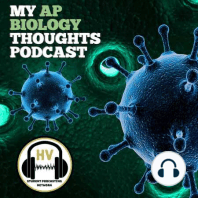11 min listen
DNA & RNA Structure
ratings:
Length:
6 minutes
Released:
Jun 2, 2021
Format:
Podcast episode
Description
My AP Biology Thoughts Unit 6 Gene Expression and RegulationWelcome to My AP Biology Thoughts podcast, my name is Jacqueline Sun and I am your host for episode #105 called Unit 6 Gene Expression and Regulation: DNA and RNA Structure. Today we will be discussing the central structural components of DNA and RNA as well as the similarities and differences between the two.Segment 1: Introduction to DNA and RNA Structure Deoxyribonucleic acid, DNA, and ribonucleic acid, RNA, are two of the most important biological molecules for survivalDNA responsible for carrying genetic information is commonly considered the “blueprint” for life’s functions. Its basal structure, a double helix that is unique from RNA, is key to its ability to replicate itself. DNA, when not undergoing replication, is coiled up into compact structures known as chromosomes. They are wrapped around histone proteins: the degree of tightness to which they are wrapped determines how much of the DNA is expressed.RNA builds off of DNA and creates a template from which proteins can be created in ribosomes. Because they are based off of a parent DNA strand, RNA has a single strand instead of two.Segment 2: More About DNA and RNA Structure However, there is much more to DNA and RNA Structure than the helical strands.Lets first focus on what makes up the strands for DNA and RNA:Both DNA and RNA have a sugar-phosphate backbone that is key to holding the entire molecule together. However, the sugar in DNA is deoxyribose sugar, from which it derives its name. The sugar in RNA is ribose sugar, which has one more hydroxyl group than the sugar in DNA. The sugar and phosphate group in DNA and RNA alternate repeatedly. They link with a special directionality that is often denoted with a 5’ and 3’ end. This is a rather abstract concept, but basically the 5’ and 3’ indicate which carbon in a sugar molecule the phosphate group will attach itself, forming the repeating phosphate-sugar backbone.Another central structural component are the nitrogenous bases found in both DNA and RNA, with one key difference.DNA has the bases adenine, cytosine, guanine, and thymine. Adenine and guanine are known as purine bases, while cytosine and thymine are the pyrimidine bases. Purines tend to be larger than pyrimidines because purines have a double ring structure as opposed to pyrimidine’s single ring structure.Only purines and pyrimidines can bind together. Specifically, in DNA, adenine and thymine bind together, while cytosine and guanine bond together. They are held together by hydrogen bonds which link not only the bases, but also the two strands of DNA to form a double helix. The 1:1 ratio by which the nitrogenous bases bond (adenine=thymine, guanin=cytosine) explains how DNA molecules are able to replicate by synthesizing a new strand from a parent...
Released:
Jun 2, 2021
Format:
Podcast episode
Titles in the series (100)
Darwin’s Early Life by My AP Biology Thoughts
